
The Lamiaceae or Labiatae are a family of flowering plants commonly known as the mint, deadnettle or sage family. Many of the plants are aromatic in all parts and include widely used culinary herbs like basil, mint, rosemary, sage, savory, marjoram, oregano, hyssop, thyme, lavender, and perilla, as well as other medicinal herbs such as catnip, salvia, bee balm, wild dagga, and oriental motherwort. Some species are shrubs, trees, or, rarely, vines. Many members of the family are widely cultivated, not only for their aromatic qualities, but also their ease of cultivation, since they are readily propagated by stem cuttings. Besides those grown for their edible leaves, some are grown for decorative foliage. Others are grown for seed, such as Salvia hispanica (chia), or for their edible tubers, such as Plectranthus edulis, Plectranthus esculentus, Plectranthus rotundifolius, and Stachys affinis. Many are also grown ornamentally, notably coleus, Plectranthus, and many Salvia species and hybrids.

Rosaceae, the rose family, is a medium-sized family of flowering plants that includes 4,828 known species in 91 genera.

Dracocephalum is a genus of flowering plants in the family Lamiaceae, native to temperate regions of the Northern Hemisphere. These flowers, collectively called dragonhead, are annual or perennial herbaceous plants or subshrubs, growing to 15 to 90 centimeters tall. The genus has 89 species as currently circumscribed, which includes the formerly separate genera Hyssopus, Lallemantia, and others. Older circumscriptions include 60 to 70 species.

The Casuarinaceae are a family of dicotyledonous flowering plants placed in the order Fagales, consisting of four genera and 91 species of trees and shrubs native to eastern Africa, Australia, Southeast Asia, Malesia, Papuasia, and the Pacific Islands. At one time, all species were placed in the genus Casuarina. Lawrence Alexander Sidney Johnson separated out many of those species and renamed them into the new genera of Gymnostoma in 1980 and 1982, Allocasuarina in 1982, and Ceuthostoma in 1988, with some additional formal descriptions of new species in each other genus. At the time, it was somewhat controversial. The monophyly of these genera was later supported in a 2003 phylogenetic study of the family. In the Wettstein system, this family was the only one placed in the order Verticillatae. Likewise, in the Engler, Cronquist, and Kubitzki systems, the Casuarinaceae were the only family placed in the order Casuarinales.

The genus Pulsatilla contains about 40 species of herbaceous perennial plants native to meadows and prairies of North America, Europe, and Asia. Derived from the Hebrew word for Passover, "pasakh", the common name pasque flower refers to the Easter (Passover) flowering period, in the spring. Common names include pasque flower, wind flower, prairie crocus, Easter flower, and meadow anemone. Several species are valued ornamentals because of their finely-dissected leaves, solitary bell-shaped flowers, and plumed seed heads. The showy part of the flower consists of sepals, not petals.

Salvia yangii, previously known as Perovskia atriplicifolia, and commonly called Russian sage, is a flowering herbaceous perennial plant and subshrub. Although not previously a member of Salvia, the genus widely known as sage, since 2017 it has been included within them. It has an upright habit, typically reaching 0.5–1.2 metres tall, with square stems and gray-green leaves that yield a distinctive odor when crushed. It is best known for its flowers. Its flowering season extends from mid-summer to late October, with blue to violet blossoms arranged into showy, branched panicles.

Polygonum is a genus of about 130 species of flowering plants in the buckwheat and knotweed family Polygonaceae. Common names include knotweed and knotgrass. In the Middle English glossary of herbs Alphita, it was known as ars-smerte. There have been various opinions about how broadly the genus should be defined. For example, buckwheat has sometimes been included in the genus as Polygonum fagopyrum. Former genera such as Polygonella have been subsumed into Polygonum; other genera have been split off.
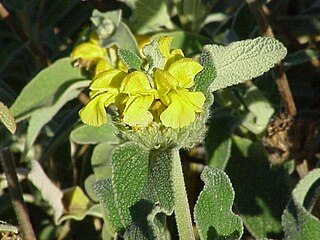
Phlomis is a genus of over 100 species of herbaceous plants, subshrubs and shrubs in the mint family Lamiaceae, native from the Mediterranean region east across central Asia to China.
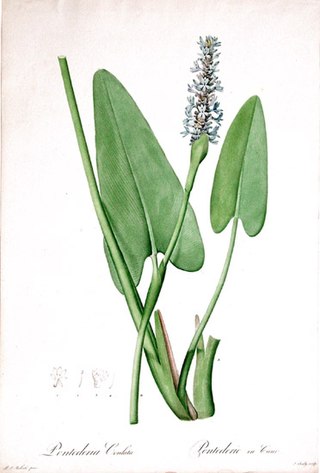
Pontederia is a genus of tristylous aquatic plants, members of which are commonly known as pickerel weeds. Pontederia is endemic to the Americas, distributed from Canada to Argentina, where it is found in shallow water or on mud. The genus was named by Linnaeus in honour of the Italian botanist Giulio Pontedera.

Monarda is a genus of flowering plants in the mint family, Lamiaceae. The genus is endemic to North America. Common names include bergamot, bee balm, horsemint, and oswego tea, the first being inspired by the fragrance of the leaves, which is reminiscent of bergamot orange. The genus was named for the Spanish botanist Nicolás Monardes, who wrote a book in 1574 describing plants of the New World.
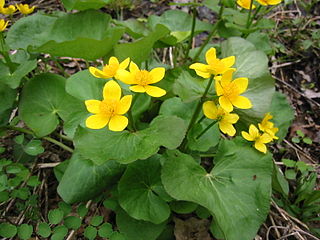
Caltha is a genus of rhizomatous perennial flowering plants in the family Ranunculaceae, to which ten species have been assigned. They occur in moist environments in temperate and cold regions of both the Northern and Southern Hemispheres. Their leaves are generally heart-shaped or kidney-shaped, or are characteristically diplophyllous. Flowers are star shaped and mostly yellow to white. True petals and nectaries are missing but the five or more sepals are distinctly colored. As usual in the buttercup family there is a circle of stamens around free carpels.

Ballota (horehound) is a genus of flowering evergreen perennial plants and subshrubs in the family Lamiaceae. native to temperate regions. The Mediterranean region has the highest diversity in the genus, with more isolated locations in South Africa, Central Asia, northern Europe, and the islands of the eastern North Atlantic. It is found in rocky and waste ground.
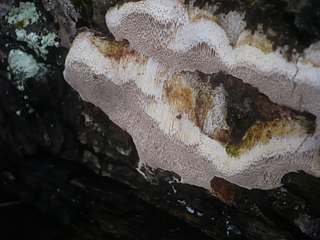
Perenniporia is a cosmopolitan genus of bracket-forming or crust-like polypores in the family Polyporaceae. They are dimitic or trimitic with smooth, thick-walled basidiospores and cause a white rot in affected wood.

Coleus scutellarioides, commonly known as coleus, is a species of flowering plant in the family Lamiaceae, native to southeast Asia through to Australia. Typically growing to 60–75 cm (24–30 in) tall and wide, it is a bushy, woody-based evergreen perennial, widely grown for the highly decorative variegated leaves found in cultivated varieties. Another common name is painted nettle, reflecting its relationship to deadnettles, which are in the same family. The synonyms Coleus blumei, Plectranthus scutellarioides and Solenostemon scutellarioides are also widely used for this species.

Salvia is the largest genus of plants in the sage family Lamiaceae, with nearly 1000 species of shrubs, herbaceous perennials, and annuals. Within the Lamiaceae, Salvia is part of the tribe Mentheae within the subfamily Nepetoideae. One of several genera commonly referred to as sage, it includes two widely used herbs, Salvia officinalis and Salvia rosmarinus.
Phlomoides eremostachydioides is a species of flowering plant in the mint family, Lamiaceae. It is a subshrub endemic to the Karatau Mountains of Kazakhstan in central Asia.

Phlomoides, also called Jerusalem sage and Lampwick plant, is a genus of over 130 species of flowering plants in the family Lamiaceae, native from the eastern Mediterranean Basin through Eastern Europe, western and central Asia, and the Indian subcontinent to China, Korea, and the Russian Far East. Phlomoides now comprises many species formerly in the genus Phlomis, and the former genera Eremostachys, Lamiophlomis, Notochaete, and Pseuderemostachys.
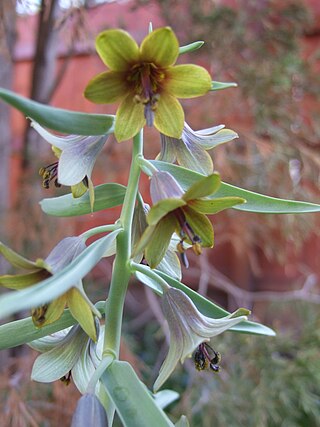
Fritillaria sewerzowii is a perennial herbaceous bulbous plant, distributed in alpine areas of central Asia. It is a species in the genus Fritillaria, in the lily family Liliaceae. It is placed in the subgenus Korolkowia.

Reynoutria is a genus of flowering plants in the Polygonaceae, also known as the knotweed or buckwheat family. The genus is native to eastern China, Eastern Asia and the Russian Far East, although species have been introduced to Europe and North America. Members of the genus, including R. japonica and its hybrid with R. sachalinensis, are highly invasive plants.

Lamioideae is a subfamily of plants in the family Lamiaceae.


















